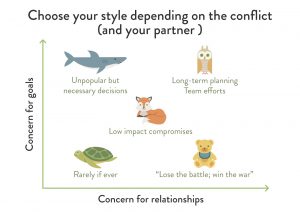Styles of Conflict Management
We’ve already begun a discussion about conflict in our article Conflict Can Be Good, where we concluded that conflict is inevitable and part of all of our relationships. We discovered that conflict can be good and has many benefits when managed appropriately. Given this, it’s best to embrace the inevitability of conflict and learn how to manage it. Learning conflict management doesn’t mean subscribing to only one pattern. Clearly, everyone has their own styles of conflict management.
Uniqueness and patterns in managing conflicts
Each person has a unique style which reflects their own unique wants, needs, and values. However, there are specific global patterns in conflicts that can be identified based on how we deal with such challenges. The important thing to remember is that no one style is a pure typology and inherently better than any other.
You must be wondering, What are the benefits of being aware of my own style? Well, as you recognize your style you can better understand its strengths and weaknesses. Also, you can increase your ability to adopt different styles relative to the inevitable conflicts that arise in all interpersonal relationships as you learn when each style is best to employ.
Styles of Conflict Management and their Representative Animals
According to two researchers, Thomas and Kilmann, we can identify five conflict-handling styles: competing, collaborating, avoiding, accommodating, and compromising. To illustrate these styles, they selected specific animals, because various personality traits can be represented in a more balanced strengths-and-weaknesses framework this way.
The Competitive Shark
Do it my way or not at all!
This is the typical attitude of the shark. Sharks use a forcing or competing style to achieve their goals. They have a need to win – therefore, others must lose. When competing, an individual pursues his or her own concerns at the other person’s expense, using whatever power seems appropriate to win their position – even if it means being uncooperative, threatening, and intimidating. They strongly defend a position they believe is correct or simply try to win.
If the shark’s decision is truly correct, a better decision can result. However, it may result in hostility and resentment toward the shark, or damaged relationships.
This style may be appropriate for emergencies when you need quick, decisive action, and people are aware of and support the approach, or when unpopular decisions need to be implemented.
The Collaborative Owl
My preference is … What’s your choice?
Owls use a collaborative or problem-confronting conflict management style. Owls value their goals and relationships. They gather information, look for alternatives, dialogue openly, and welcome disagreement. Owls view conflicts as problems to be solved and work to find solutions agreeable to all sides.
The advantage of this strategy is that relationships are maintained (because both sides get what they want) and negative feelings are eliminated. On the other hand, this takes a great deal of time and effort to synthesize everybody’s ideas.
The appropriate time to use an Owl style is when the issues and relationship are both important.
The Avoidant Turtle
Conflict? What conflict?
Turtles avoid, withdraw, deny, or delay conflicts. They would rather hide and ignore conflict than resolve it – this leads them to be uncooperative and unassertive. Turtles even tend to give up personal goals.
This may help to maintain relationships that would be hurt by conflict resolution, but conflicts and negative feelings may linger, too.
This is often appropriate when the issue is trivial or the relationship is insignificant. Sometimes it can be effective when the atmosphere is emotionally charged and you need to create some space.
The Accommodating Teddy Bear
Whatever you say.
Teddy bears use a soothing or accommodating conflict-management style with emphasis on human relationships. They agree and flatter because they have a need to please everyone involved. Therefore, teddy bears often neglect their own desired outcomes to satisfy those of the others. There is an element of self-sacrifice.
Sometimes accommodating maintains relationships, but the bear may be taken advantage of.
However, it’s good to use this when you really don’t care about the issue or when you realize you are wrong (and the other party has a better solution).
The Compromising Fox
I’ll give you this if you give me that.
Foxes use a compromising conflict-management style. Individuals who use this approach are concerned about goals and relationships. They have a strategy of a little something for everyone – they tend to find mutually acceptable solutions that partially satisfy both parties.
Foxes are willing to sacrifice some of their goals while persuading others to give up part of theirs. Compromise is assertive and cooperative.
This way it is possible to maintain relationships and find solutions, but compromise is not always ideal.
Compromising is suitable to use in situations when complex issues have no clear solutions or when people in conflict have equally important solutions.
How to use styles of conflict management?
Imagine that you’re going out with a friend. You want to go to the movies and relax. However, your friend wants to go shopping, because they’re attending an important event that evening and want to find a really nice outfit. How do you decide where you’re going?
You love your friend, you want them to be happy, so it’s okay if you please them and go to the shopping center with them.
But, let’s imagine the second scenario – everything’s the same except that today’s the last day that movie is playing! And you really want to see it… What would you do this time?
Would you choose to be a compromising fox? If I help you buy an outfit for that event, you go to the movie with me.
What do you think about these scenarios? How do you choose how to react? The fastest way is to consider your concern for goals and concern for relationships. Check out the graphic below.

Abraham Maslow said If the only tool you have is a hammer, you tend to see each problem as a nail. Likewise, if you have only one predominant conflict resolution style, there are inherent limitations or blind spots, which is why we’ve sought here to help you expand your usual conflict style by introducing other styles and approaches.
In Nobel Explorers, we want everyone to learn how to manage conflicts in the most effective way. So, if you find this article useful and want to practice the skills significant for managing conflict – negotiation, check out which projects we offer.
Resources:
[1] Eckstein, D. (1998). Styles of conflict management. The Family Journal, 6(3), 240-243.
[2] Thomas, K.W. and Kilmann, R.H. (1974). Conflict Mode Instrument, Sterling Forest, New York.





